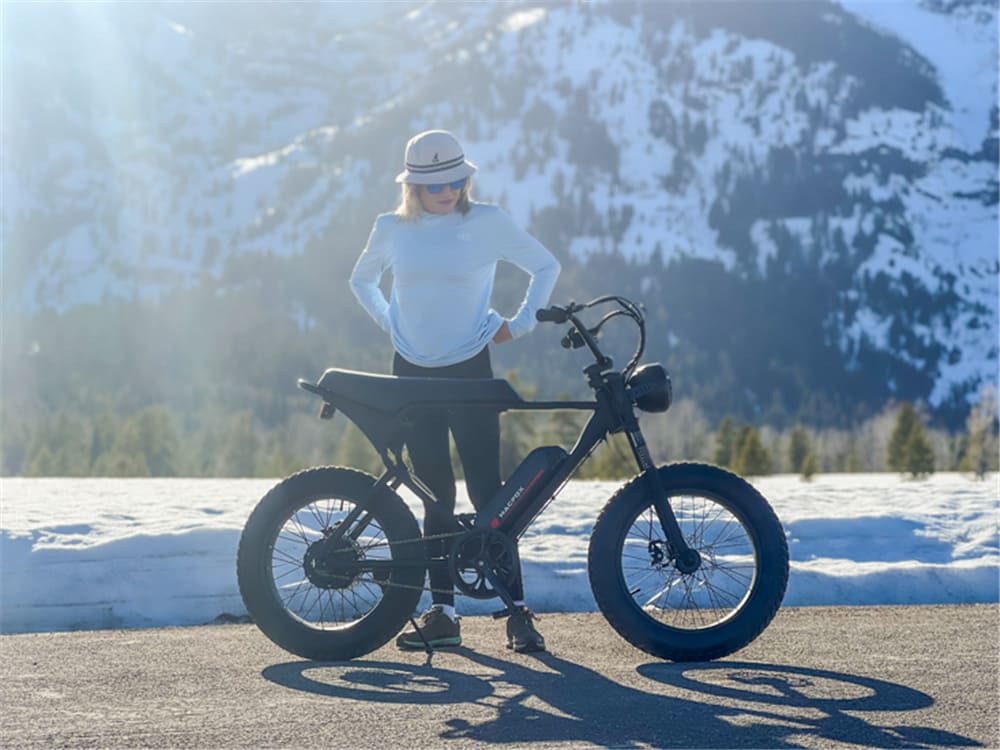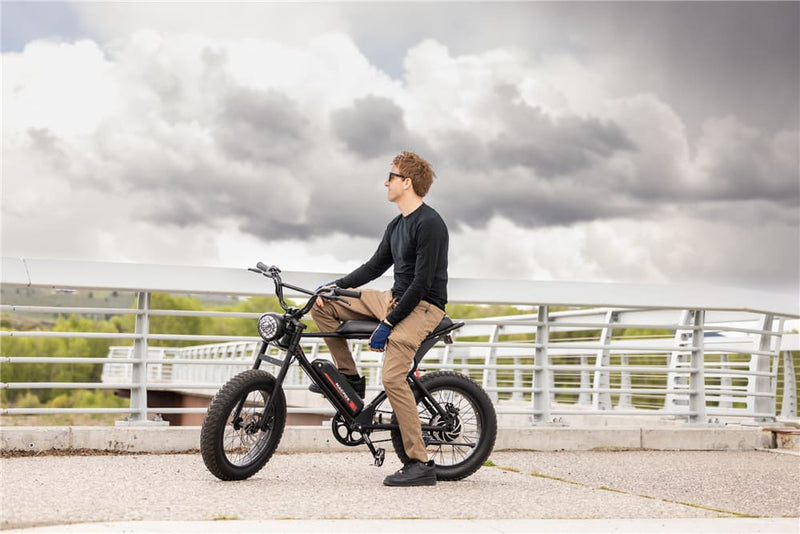Finding an electric bike (e-bike) or motorcycle may be challenging; both offer green, efficient travel methods while catering to individual needs and lifestyles. This guide explores the world of electric bicycles and motorcycles, exploring their main differences, pros and cons, and outlining legal and regulatory frameworks that regulate their usage. We will also share essential tips for riding an electric bicycle and take a closer look at the Macfox X1, an outstanding electric bicycle explicitly designed for urban commuters. No matter whether your preference lies with an e-bike or an electric motorcycle, read on to discover which option best meets your needs!
Electric Bicycles and Electric Motorcycles: Main Differences

The line between electric bicycles and electric motorcycles might seem thin at first glance, but several key differences define each mode of transportation. Let’s break it down:
-
Power and Speed at the Core
One of the primary distinctions between electric bicycles and motorcycles lies in their respective power output and speed capabilities.
Electric Motorcycles: These are the heavy hitters in the electric world, equipped with powerful motors that easily surpass the 750 watts limit that typically defines an e-bike. Electric motorcycles are designed for speed and long-distance travel, capable of reaching highway speeds and offering a thrilling ride. They're equipped with larger batteries to support their high-power output, which translates into longer range capabilities but also longer charging times.
E-Bikes:E-bikes combine pedal power with electric assistance, limiting their top speed to keep them accessible and safe across various environments such as bike paths and urban streets. Motor assistance usually stops between 20 to 28 mph depending on the class of e-bike. This assistance level was designed to augment human power rather than replace it, making e-bikes ideal for maintaining active lifestyles while giving extra boost over hills or long rides.
-
Design and Aesthetics: Form Follows Function
E-bikes and electric motorcycles possess distinct design philosophies reflecting their intended uses and rider expectations.
Electric motorcycles are designed to resemble their traditional counterparts in terms of size and appearance. They feature larger frames with prominent seating positions and an emphasis on speed and aerodynamics. They often boast larger wheels equipped with suspension designed for high-speed stability and an aggressive riding position to cope with faster travel speeds.
E-bikes resemble traditional bicycles in design and function, providing cyclists of different riding styles (from urban commuting to off-road biking ) with options that suit different riding styles ranging from urban commuting and off-roading to off-road biking. E-bikes typically weigh less than electric motorcycles, making them easier to handle and store; additionally, their emphasis on comfort and efficiency allows features like cargo racks and integrated lights for practical everyday use.
-
Usage and Accessibility: Where Can You Ride?
Electric motorcycles are designed primarily for road use. They must meet similar legal permission requirements as traditional bikes, including licenses, registration, and insurance in many jurisdictions. While this restricts their accessibility somewhat, electric motorcycles still provide a conventional riding experience without emissions emissions.
E-bikes provide an impressively diverse set of uses. Depending on local regulations, their designs vary between bike paths and off-road trails, making e-bikes an appealing solution for multipurpose transportation needs that can adapt to various environments and climates.
-
Choose Your Electric Ride
As with anything, selecting an e-bike and an electric motorcycle ultimately depends on your unique needs, preferences, and intended use. If you seek something capable of high speeds and longer distances with a motorcycle-esque experience, an electric motorcycle may be your perfect fit; alternatively, if versatility, exercise, and being able to navigate different environments without a license or registration are paramount, an e-bike may be more suitable.
Both electric bikes and motorcycles represent sustainable, efficient, and enjoyable modes of transport. By understanding their differences, you can more accurately evaluate which option best meets your lifestyle and transportation requirements - ensuring a fulfilling riding experience in the present and future.
Related Reading: Explore the Coast Path on an Electric Bike
Advantages and Disadvantages of Electric Bicycles and Motorcycles:
Electric Bicycles:
-
Advantages:
- Eco-friendly and Economical: E-bikes use less energy and are cheaper to charge and maintain compared to electric motorcycles and traditional vehicles.
- Health Benefits: Riding an e-bike involves physical exertion, which can improve fitness levels.
- Ease of Use: The regulations around e-bikes are generally more relaxed, making them an easy choice for many.
-
Disadvantages:
- Limited Range and Speed: E-bikes can’t go as fast or as far on a single charge as electric motorcycles.
- Physical Effort: For some, the need to pedal might be a downside, especially on longer commutes or hot days.
Electric Motorcycles:
-
Advantages:
- Speed and Power: For those looking for speed, electric motorcycles offer a thrilling ride.
- Longer Range: Equipped with larger batteries, they can cover more distance on a single charge.
- No Emissions: Like e-bikes, they’re a green alternative to gasoline-powered vehicles.
-
Disadvantages:
- Cost and Regulations: Higher upfront costs, along with the need for licenses and insurance.
- Limited Use Cases: Not as versatile as e-bikes in terms of where they can be ridden.
Navigating the Legal Landscape for E-bikes
The legal and regulatory framework for e-bikes can seem like a complex maze of rules and definitions, with laws not universally standardized and often differing according to region. In the US, for instance, the Consumer Product Safety Act defines e-bikes as bicycles equipped with electric motors of less than 750 Watts (1 horsepower), powered solely by such motors while being operated by operators who weigh 170 pounds - with top speeds on flat surfaces below 20 mph while solely powered by such motor. However, this definition only scratches the surface - complexity lies ahead when considering all laws are different for different regions - as each law differs significantly in its approach versus each region's different regulations in regards to what defines exactly as an e-bike differently depending upon where in this matter begins for example!
-
Federal Vs. State Regulations
While federal definitions set a baseline, states are free to develop their regulations about e-bike use in their jurisdiction, including restrictions that might include:
- Classification Systems:Most states utilize a three-tier classification system for e-bikes. Class 1 bikes use pedal-assists with no throttle for assistance and reach 20 mph maximum assisted speeds; class 2 bikes have similar maximum assisted speeds but utilize throttle assist; finally, class 3 bikes only use pedal-assists with 28mph max speeds.
- Helmet Laws:Some states mandate helmet use when riding certain classes of e-bikes, often depending on age or bike classification.
- Access Rights:State and local laws may limit which types of e-bikes can be used on bicycle paths, trails, or sidewalks; for instance, Class 3 models are often prohibited unless adjacent to a roadway.
- Age Restrictions:The minimum age for riding an electric bicycle may differ by location; sometimes, 16 may be the threshold age for higher-class models.
-
Global Perspectives
The regulatory environment surrounding electric bicycles can be complex worldwide. In Europe, for instance, bikes with 250W motors assisting riders up to 25 km/h (15.5mph) are considered bicycles and, therefore, don't need a license, registration, or insurance; faster or more powerful electric bikes may fall into different categories with stricter regulations that must be met.
-
Stay Informed and Comply
Given the wide range of regulations surrounding electric bikes, prospective owners and riders must familiarize themselves with any applicable laws or requirements specific to their region before purchasing or riding an e-bike. Here are some helpful hints for staying legal:
- Check Local Regulations: Before purchasing an e-bike, look into your local laws regarding e-bike classification, helmet requirements, age restrictions, and where you can legally ride.
- Be Aware of Changes: With more people riding e-bikes becoming popular, laws and regulations surrounding their use may change over time. Stay informed of any modifications in your area to remain compliant and ensure continued riding success.
- Safety Equipment: Regardless of legal requirements, riders of any experience level should invest in proper safety gear, such as helmets and reflective clothing.
- Insurance:Although not legally necessary, purchasing insurance for your e-bike may provide peace of mind, especially with high-value models.
Navigating the legal and regulatory framework surrounding electric bikes takes some effort. Stilit l, ensuring your adoption of this eco-friendly, effective mode of transport remains safe and lawful. By understanding and abiding by local laws in your area, e-biking offers many benefits while remaining lawful and safe.

Tips and Best Practices for Riding an E-bike
- Stay Informed on Local Laws: Knowing the rules of the road (or path) is essential for safe and legal e-bike use.
- Wear a Helmet: Safety first! Always protect your noggin.
- Be Mindful of Pedestrians and Other Cyclists: Share the path responsibly, signaling your intentions and passing with care.
- Regular Maintenance: Keep your e-bike in tip-top shape with regular checks on the battery, tires, and brakes.
Product Spotlight: Macfox Electric Bicycle
The Macfox X1 is a great urban electric commuter bike. Featuring an efficient 500W motor with 750W peak power and a top speed of 25 MPH, its impressive range extends to 38 miles on just one battery or 76 miles with dual batteries. However, in addition to power and range, it is also designed to cater perfectly to urban life, with a high-strength steel frame, 20"*4.0" CST tires designed for urban terrain, and mechanical disc brakes that provide reliable stopping power; in addition, The LCD screen keeps you informed of speed, range and battery status - making the Macfox X1 a standout contender for city commutes that prioritize efficiency, durability and design!
Conclusion
In conclusion (or should we say, wrapping this ride up), the choice between an electric bike and an electric motorcycle hinges on your personal needs, lifestyle, and local regulations. Whether you’re leaning towards the eco-friendly versatility of an e-bike like the Macfox X1 or the power-packed thrill of an electric motorcycle, both paths lead to a greener, more efficient mode of transportation. Whichever you choose, you’re not just picking a ride; you’re embracing the future of mobility. Happy riding!
FAQs
Do I require a license to ride an e-bike?
In most jurisdictions, no license is usually necessary to ride an e-bike; however, it's wise to check local regulations, as they may differ depending on where you reside.
How quickly can electric motorcycles travel?
Electric motorcycles can reach highway speeds, and certain models, depending on their make and model, can exceed 100 mph.
Can electric bicycles be ridden on bike paths?
Yes, e-bikes can typically be ridden on bike paths. However, local regulations may prohibit specific e-bikes, so it is wise to verify what rules exist in your region before riding one.
We recommend for you:
- Your guide to electric bike tax credits and rebates in the United States in 2024
- How to Say Goodbye to the Worries of Traditional Cycling
- Why Electric Bikes Are a Great Companion for Your Wilderness Rides
- Electric Bike Drivetrains: Myths Debunked and Issues Solved
- Want to Start Off-Road Riding? Newbies, Take a Look at This X2


















